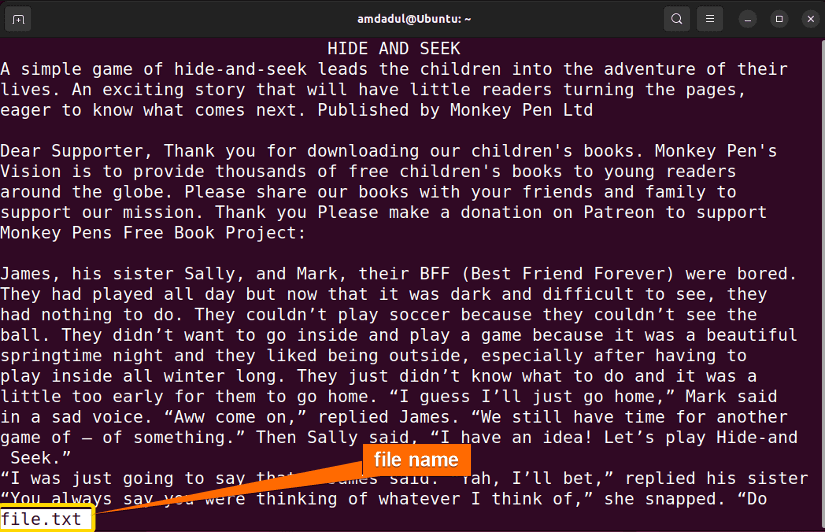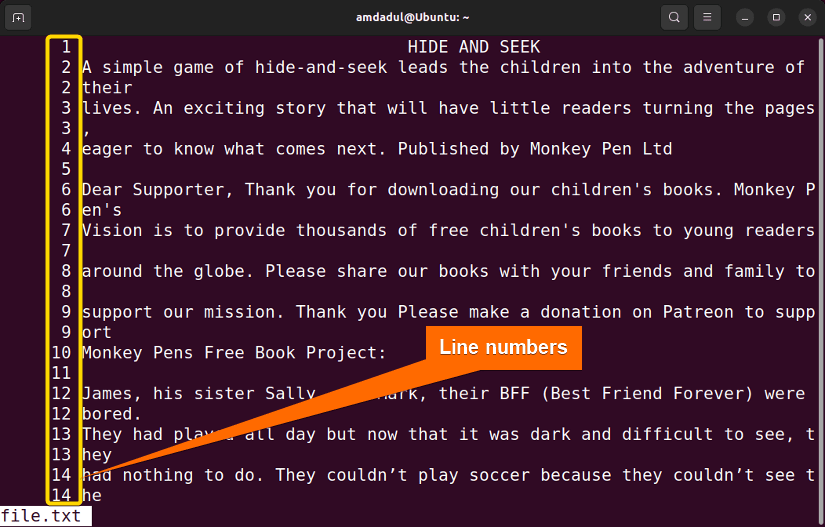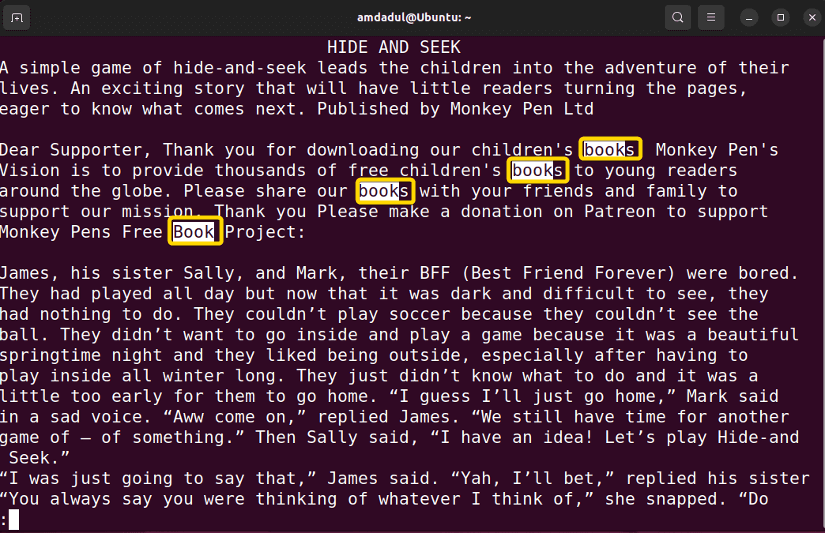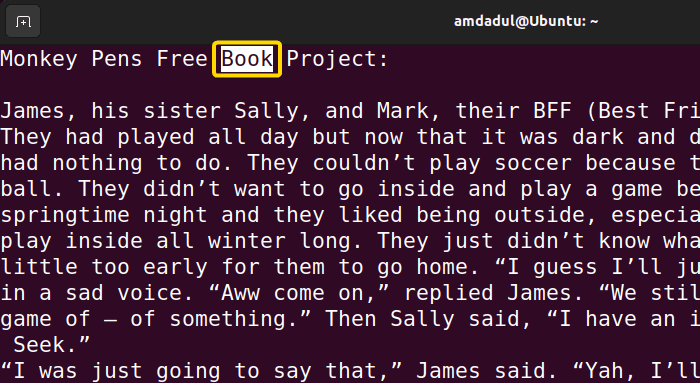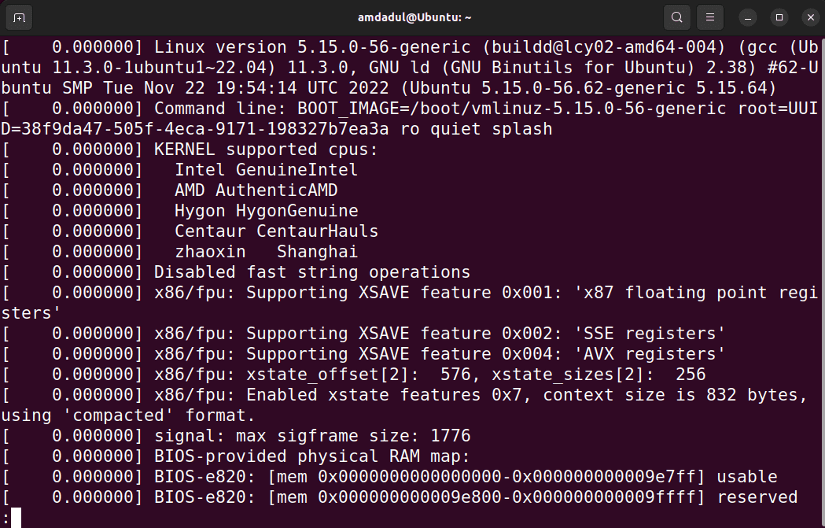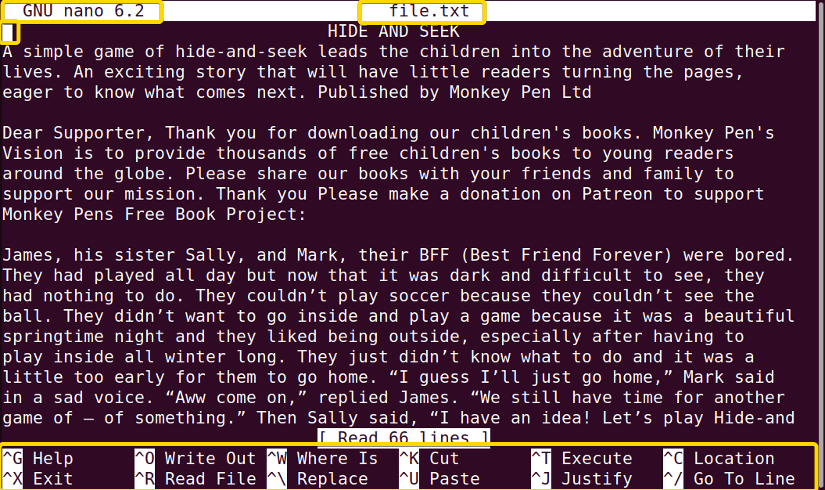The less command in Linux is a frequently used command to view any file, though it doesn’t provide an editing opportunity. It helps viewers to see a document page by page and gives better control to navigate through the file.
A. Description
less is a handy command in Linux that shows any file’s contents one page at a time. This command is more useful when viewing a large file with many lines because it doesn’t load the entire file, so it gives a first loading speed.
Note: You can navigate through the texts using the ARROW keys and navigate page to page using the SPACE key.
B. Syntax
The syntax of less command in Linux is very simple which is as below:
less [OPTIONS]... (FILE_PATH OR FILE_NAME)Note: In the syntax above square bracket means the OPTIONS are not mandatory and three dots after the square bracket means multiple OPTIONS can be used after the less command.
C. Options
There are many useful options available for the less command. I have listed some of the most used options which are given below. You can know more about options and their use by checking the man page.
man lessUseful Options
- -E: To take the automatic exit after reaching the end of a file.
- -f: Use to force less to open non-regular files.
- -F: Open the file in the terminal when the entire file can be displayed on the first screen.
- -i: Ignores case sensitivity
- -n: Remove the line number from the screen.
- -N: Display the line number at the beginning of each line.
- -p[pattern]: Start the file from the line that contains the pattern for the first time.
- -s: Marge multiple spaces in one space.
- z[n]: Change the scrolling window size to n line.
NB: The options in Linux CLI (Command Line Interface) are all case-sensitive, So be cautious while using them.
Practical Examples of the “less” Command in Linux
less is a helpful command that helps to show a document in a manageable way. In the section below I will show you some most useful applications with less command in Linux.
Example 1: Open a Text File With the “less” Command in Linux
You can view a file’s contents page by page by opening that file with less command in Linux. For this, you can use a relative path or an absolute path of the file location. Here, I have a file named file.txt under the location /home/amdadul. Now, I will display this file page by page. To do so you can follow the below procedure.
Steps to Follow >
➊ At first open the Ubuntu Terminal.
➋ Type the following command in the command prompt:
less file.txt➌ Now, press the ENTER button.
Output >
In the following image, you can see that less has displayed the contents of file.txt on one page at a time format.
Example 2: Open a Text File With Line Number
To display the line number of a specified file you can use the -N option after less command. Here I will show you the file.txt with the line number and to do so you can follow me in the manner I describe below.
Steps to Follow >
➊ At first open the Ubuntu Terminal.
➋ Type the following command in the command prompt:
less -N file.txt➌ Now, press the ENTER button.
Output >
In the image below, you can see the file’s contents with line numbers.
Example 3: Search for a String With the “less” Command in Linux
You can search for a specific pattern under the terminal of less command. /PATTERN is used to search forward from the current position for the PATTERN string and ?PATTERN is used to search backward from the current position for the PATTERN string. You will see the search phrase at the bottom line of the less terminal display. Now, I will show you the process to search for something, to do so you can follow me in the manner I describe below.
Note: Searching in less is case-sensitive. You can ignore case sensitivity by using the -I option or pressing the I key within less.
Steps to Follow >
➊ At first open the Ubuntu Terminal.
➋ Type the following command in the command prompt:
less -I file.txt➌ Now, press the ENTER button. After pressing ENTER the file will open and you will see the search phrase at the bottom as in the image below.
➍ Type the string which you want to search in the search phrase. Here, I will search for the string “book”.
Output >
When I search for the string book the result I get as the image below. You will get the same for your desired search.
Example 4: Open a File Starting With a Specific Pattern
If you want to open a file from a line that contains a specific PATTERN for the first time in the document then you can use the -p option before the desired PATTERN. I am adding an example that you can follow according to the process below
Steps to Follow >
➊ At first open the Ubuntu Terminal.
➋ Type the following command in the command prompt:
less -p Book file.txt➌ Now, press the ENTER button.
Output >
Through this process, you will get the result as shown in the picture below. Here, you can see that the file opens at the line where the Book string is used for the first time in the document.
Note: The search is case-sensitive.
Example 5: Remove Multiple Blank Lines
To remove multiple-line space in a document at the time of reading with less command in Linux, you can use option -s with the less command. Here I will show you an example with file2.txt that contains a multiple-line gap between two paragraphs. Without using option -s the file2.txt looks like as below.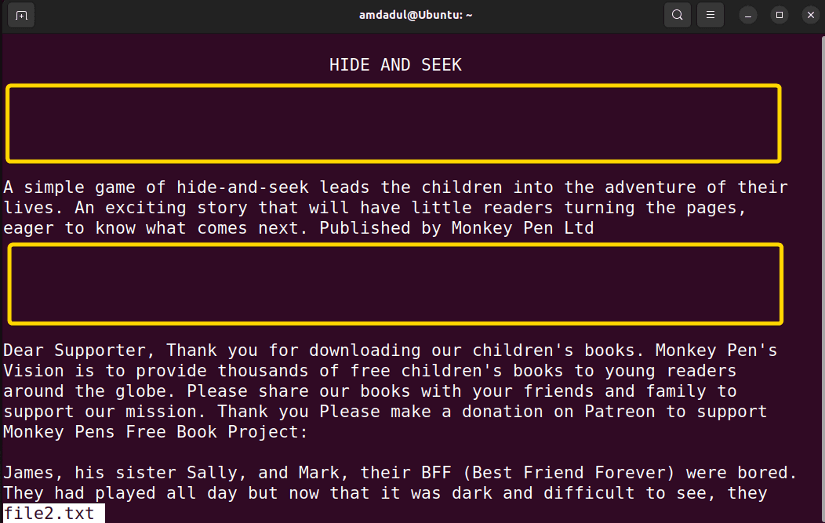
Steps to Follow >
➊ At first open the Ubuntu Terminal.
➋ Type the following command in the command prompt:
less -s file.txt➌ Now, press the ENTER button.
Output >
Now you can see, there is no unnecessary space between two lines. It helps to show more lines on one page.
Example 6: Open Multiple Files With the “less” Command in Linux
The less command can open multiple files at a time and can show them individually. In this section, I will show you, how to open multiple files together. Let’s dive into the example.
Steps to Follow >
➊ At first open the Ubuntu Terminal.
➋ Type the following command in the command prompt:
less file.txt file3.txt➌ Now, press the ENTER button.
Output >
Two files are opened together. You can move the next file by pressing “: (SHIFT+;) & N”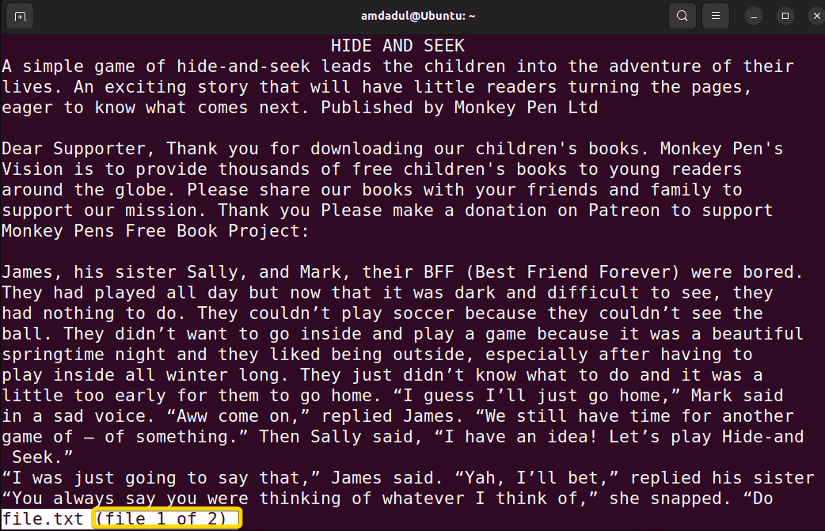
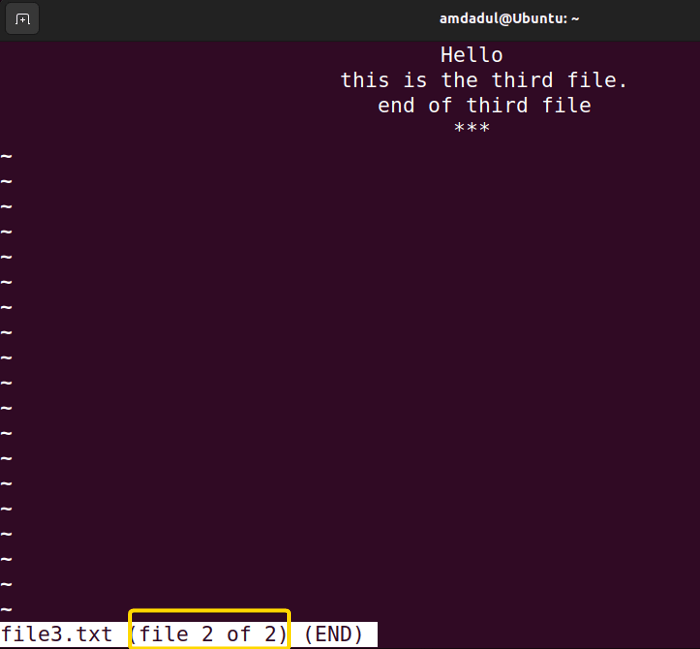
Example 7: Marking a Specific Text With “less” Command in Linux
Mainly mark is a flag. You can mark any section of a large document so that you can return to that section at any time from any part of the document. The process you can flow through is given below.
Steps to Follow >
➊ At first open the Ubuntu Terminal.
➋ Type the following command in the command prompt:
less file.txt➌ Now, press the ENTER button.
➍ Press M (which initiates the marking process) followed by a letter of your choice. To add more marks, use different letters.
Output >
You will see the following interface while initiating the marking process. Now, press any key to make that as a mark for this section; consider that you use the letter “a” as a mark.
Example 8: Real-Time Monitoring With “less” Command in Linux
The +F option with the less command in Linux allows you to monitor in real-time. less can show you the most recent messages or lines that have been added to a file in real-time by using the +F option. In the section below, I am showing you an example so that you can get a better understanding.
Steps to Follow >
➊ At first open the Ubuntu Terminal.
➋ Type the following command in the command prompt:
less +F file.txt➌ Now, press the ENTER button.
Output >
You can see in the image, less indicates that it is awaiting additional data by displaying a message. For new messages, the terminal automatically scrolls down.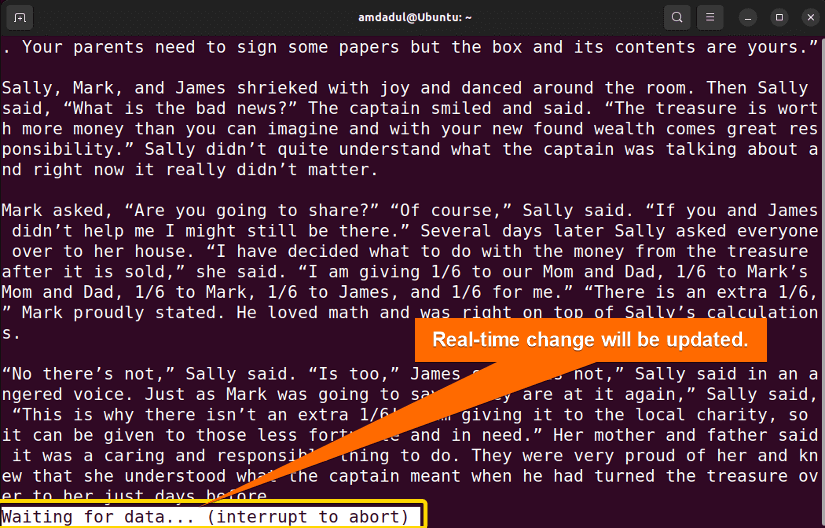
Note: In the forward mode, scrolling and paging are disabled because less only shows the bottom of the output while it waits for new messages.
Example 9: Redirecting to the “less” Command in Linux
You can use the pipe to process the output of other commands via less. It is very useful in day-to-day life. Here I will show you an example so that you can follow the manner I describe below.
Steps to Follow >
➊ At first open the Ubuntu Terminal.
➋ Type the following command in the command prompt:
sudo dmesg | lessNotes: In Linux, the sudo (Super User DO) command is frequently used as a prefix to a command that only superusers are permitted to execute.
➌ Now, press the ENTER button.
Output >
The dmesg command typically produces thousands of lines of output. You can read this output more comfortably if you pipe it to the less.
Example 10: Edit Files with the “less” Command in Linux
less provides simply the ability to see files, but it makes up for this with a shortcut that allows you to modify files. Press v when reading a file in less to move it to the system’s built-in text editor (nano is Ubuntu’s default text editor). The file will automatically reopen in less after closing the editor.
Steps to Follow >
➊ At first open the Ubuntu Terminal.
➋ Type the following command in the command prompt:
less file.txt➌ Now, press the ENTER button. It will open the file on the less terminal page.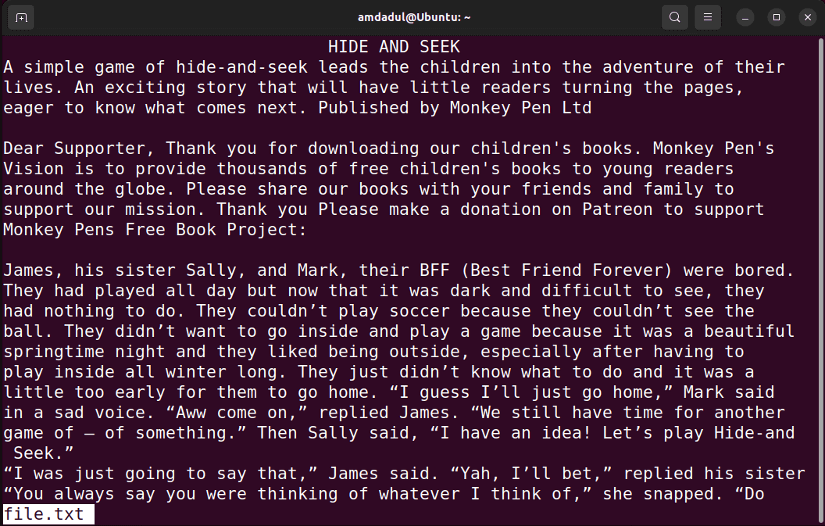
Output >
The file.txt now opens with the system’s built-in text editor nano. Now, You are able to edit the file.txt as you want.
Conclusion
I’ve demonstrated the operation of the less command in this article. Additionally, I have included some helpful examples. If you carefully read this article, you should be able to use the command less, effectively on your own.
Similar Readings
- The “cat” Command in Linux [10 Practical Examples]
- The “head” Command in Linux [7 Practical Examples]
- The “tail” Command in Linux [7 Practical Examples]
- The “more” Command in Linux [10 Practical Examples]
FUNDAMENTALS A Complete Guide for Beginners

